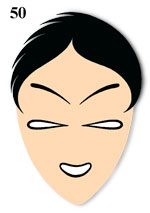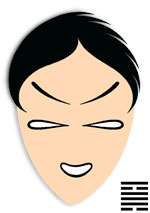

Physiognomy of symbolical emotions.
Hexagram of the canon of changes YiKing 50.


If you are art director of musical performance by way of visible gestures
or the conductor of symphonic orchestra then you can choose ensemble of
musicians according to the shown physiognomic symbols. Namely symphonic
conductors can correlate facial features of musicians to timbres and soundings
of musical instruments that emotional displays of artists can be equivalent to
sounds of music, and in essence can be equivalent to acoustic parameters
according to which violins or violoncellos are comparable to human emotions and
hexagrams of the canon of changes.
And also composers of classical music can range musical instruments in symphonic
orchestras according to hexagrams of the canon of changes and symbols of human
facial emotions.
-
Emotions of social relationships.
Eyebrows: individual mind predominates over public consciousness.
Eyes: personal volition does not depend on collective will.
Mouth: private needs predominate over social requirements.
Personality of a man or woman does not depend on volition of society, but
personal needs and mind prevail of public requirements and corporative consciousness.
Personal mutual relations.
Eyebrows: you realize people and-or companions agree with you.
Eyes: you do not see people and-or companions do not notice you.
Mouth: you can speak and-or companions listen to you.
Mental attitudes.
Eyebrows: your notion determines opinions of people.
Eyes: your point of view is neutral to sights of people.
Mouth: your words determine assertions of people.
People communicate with you and want to understand your ideas, but you can not wish to notice companions.
-
Following 51 physiognomic symbol in gallery.
About composers of classical music and emotions for musicians of symphonic orchestra, also
acoustic parameters of stylish rock bands.